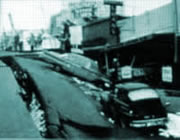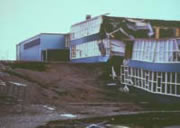 |
AAPT Winter Meeting 2006 |
 |
Lessons from the Good Friday Earthquake
Tuesday, Jan 24, 2006 09:00 - 11:00 AM 1. 1964 Alaska Earthquake: Kristine J. Crossen University of Alaska Fairbanks
The 1964 earthquake occurred at 5:36 PM on March 27, 1964. There were 4 minutes of ground motion. The magnitude was 9.2, and it affected 100,000 square miles. Earth movement ranged from 10 m upward to 2 m downwards. 137 people were killed. Landslides occurred in downtown Anchorage. There was a subsidence of 3 m along 4th Avenue. Anchorage sits on the Bootlegger Cove formation, which is a layer of gravel over a layer of weak, thixotropic clay. The clay failed and slid during the earthquake.
2. Overview of Earthquakes: Peter Haeussler USGS
We cannot avoid "big" earthquakes by relieving pressure with "little" earthquakes. We would need one every six minutes for 600 years. Earthquakes are a result of plate tectonics. As plates move against each other, pressures build up, which are released suddenly, resulting in earthquakes.
3. Alaskan Tsunamis: Paul M. Whitmore NOAA
During the 1964 earthquake, 120 of the 137 deaths were caused by tsunamis. A tsunami is a series of waves with a long wavelength and period. The period can be minutes to hours, while the wavelength can be on the order of 100 km. A tsunami is generated by the sudden displacement of sea water. This usually occurs at subduction zones. A tsunami can also be generated by a landslide. In 1958 the Lituya bay slide generated a tsnami that rose water levels up to 1720' ASL. A tsunami can also be generated by meteor or comet impact. The speed of travel depends on the depth of the water according to the equation v=sqrt(gd). In deep water, a typical speed is 500 mph.

